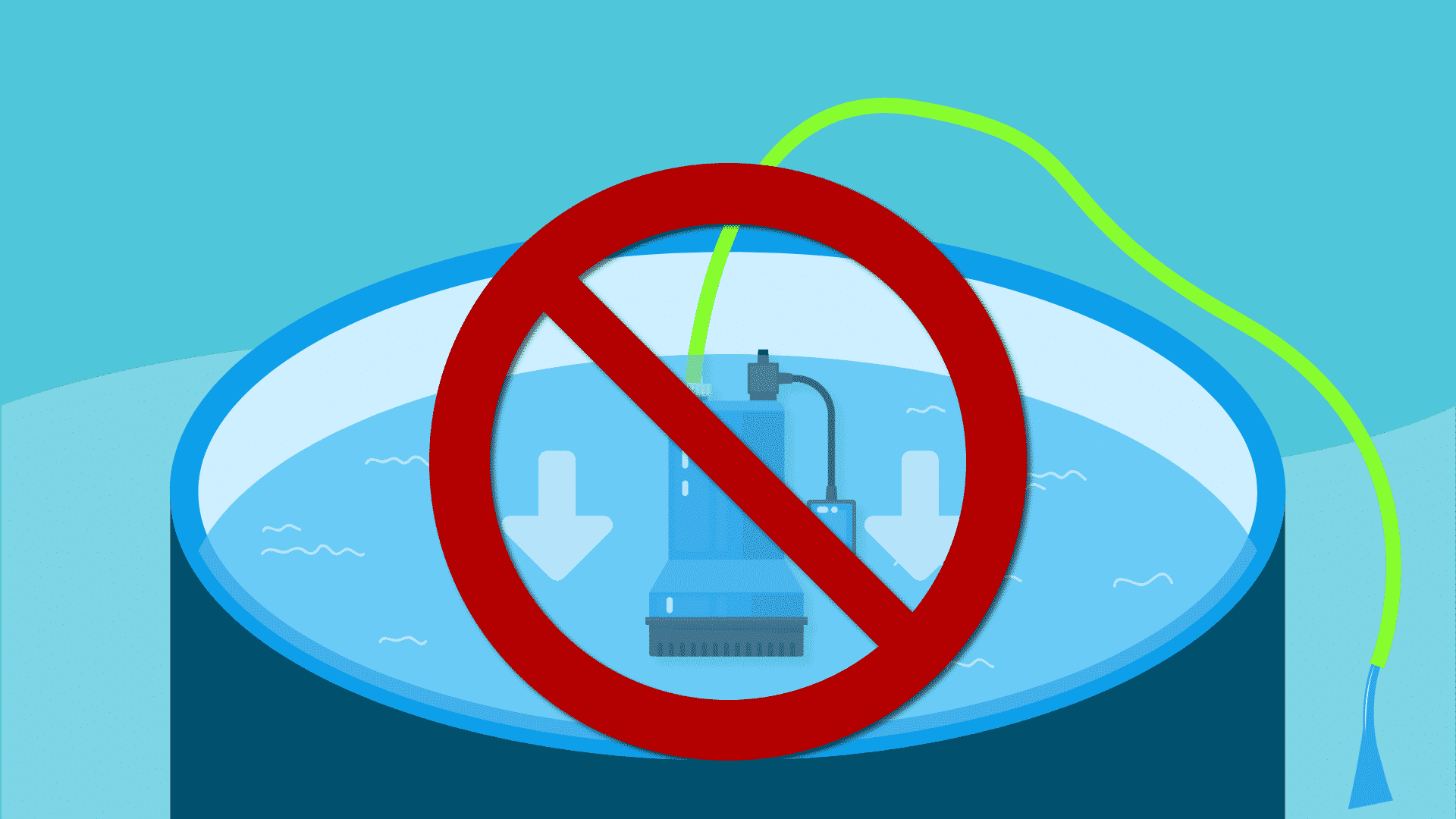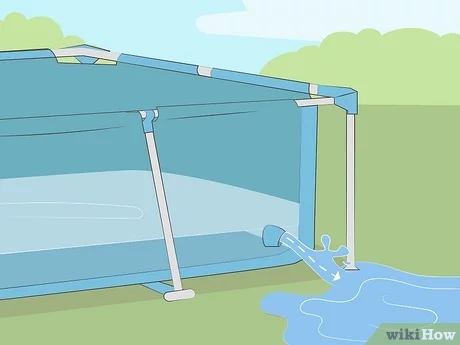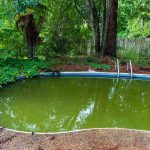To drain an above ground pool, first, locate and connect the drainage valve to a garden hose. Then, open the valve and let the water drain out completely.
Draining an above ground pool is a necessary task to maintain its cleanliness and integrity. Whether you’re preparing for winter or need to replace the water for cleaning purposes, knowing how to effectively drain your pool is essential. We will provide you with a straightforward guide on how to drain an above ground pool.
By following these simple steps, you’ll be able to ensure a smooth and hassle-free drainage process, keeping your pool in optimal condition throughout the year. So, let’s dive in and learn how to drain your above ground pool efficiently.

Credit: www.swimuniversity.com
Assessment
Before draining an above ground pool, it is crucial to assess the current condition to ensure a smooth and efficient process. This assessment involves checking the water level and inspecting the drainage system for any potential issues.
Check The Pool’s Water Level
Begin by visually inspecting the pool’s water level. Ensure that it is below the recommended drainage level to avoid any overflow during the draining process.
Inspect The Drainage System
Thoroughly examine the pool’s drainage system, including the drain plug or valve. Look for any signs of damage or blockages that may hinder the draining process.
Gathering Materials
Before you begin the process of draining your above ground pool, it’s important to gather all the necessary materials and tools. Having everything at hand will help prevent interruptions and ensure a smooth experience.
Required Tools And Equipment
Here’s a list of items you will need when draining an above ground pool:
- Pump: To remove the water from the pool, consider using a submersible pump or a pool cover pump.
- Hose: You’ll need a hose that is long enough to reach a suitable drainage location, such as a storm drain, dry well, or a sloped area away from the pool.
- Chemical Test Kit: Use a test kit to check the water chemistry before draining to ensure it’s safe to dispose of.
- Rubber Gloves: To protect your hands and skin from any potential chemical exposure.
- Bucket: A bucket will be handy for collecting water samples or small debris from the pool.
- Safety Goggles: For eye protection while handling chemicals or operating the pump.
- Pool Brush: This will help in cleaning the pool walls and floor once it’s drained.
Preparation Steps
- Turn Off Equipment: Before starting the drainage process, turn off the pool equipment including the pump, heater, and filter.
- Disconnect Power: Unplug any electrical connections such as the pump and filter from the power source to avoid accidents.
- Prepare the Draining Area: Clear the area where you will be draining the water to ensure it won’t cause any flooding or damage.
- Prepare Drainage Hose: Attach one end of the hose to the pump and place the other end in the designated drainage area.
- Test Drainage Setup: Turn the pump on briefly to ensure the water is flowing to the desired location before fully starting the drainage process.
Preparation
In preparing to drain an above ground pool, several important steps must be taken to ensure the process is completed safely and effectively:
Safety Precautions
- Wear protective gear, such as gloves and goggles, to avoid any potential hazards.
- Ensure all electrical equipment is switched off and properly disconnected.
- Use caution and avoid rushing through the draining process to prevent accidents.
Clearing The Pool Area
- Remove any furniture or objects in the vicinity of the pool to allow easy access.
- Clean and clear the pool deck of debris and obstacles for a safe work environment.
- Check the surrounding area for potential tripping hazards and address them accordingly.
Draining Process
The draining process of an above ground pool is crucial to maintain its cleanliness and to prevent any damage. In this section, we will explore the steps involved in draining an above ground pool properly.
Choosing The Right Time
Before starting the drainage process, it is essential to consider the right time to avoid wasting water and to prevent any inconvenience. Ideally, it is recommended to drain the pool during dry weather when there is no rain in the forecast.
Draining the pool when the weather is dry ensures that the water does not get contaminated with rainwater, leaves or debris, making the process easier and more efficient.
Starting The Drainage
Once you have chosen the right time, it’s time to start the drainage process. Here’s a step-by-step guide:
- First, turn off the pool’s pump and filter system to prevent any potential damage.
- Next, locate the drainage valve. It is usually located at the bottom of the pool, near the edge. If you are unable to find it, refer to the pool’s instruction manual.
- Attach a garden hose to the drainage valve and make sure it is securely connected.
- Place the other end of the garden hose in a suitable drainage area, away from your home’s foundation.
- Slowly open the drainage valve to allow the water to start flowing out. Ensure the hose is positioned correctly to avoid any backflow.
- Monitor the water level as it drains and make sure the hose remains in the drainage area. Keep in mind that the process may take a few hours, depending on the size of your pool.
- Once the water has completely drained out, remove the hose and close the drainage valve.
By following these steps, you can safely and effectively drain your above ground pool. Remember to always take precautions and seek professional advice if you are unsure about any aspect of the process.
Cleaning And Maintenance
The cleaning and maintenance of an above ground pool are essential to ensure that it remains in optimal condition. Keeping your pool clean and well-maintained not only enhances its longevity but also provides a safe and enjoyable swimming experience for everyone. In this section, we will delve into the crucial aspects of cleaning and maintaining your above ground pool, including cleaning the pool and inspecting for damage.
Cleaning The Pool
Regular cleaning of your above ground pool is key to preserving its overall condition. Skimming the surface to remove leaves, insects, and debris prevents them from sinking and affecting the pool’s cleanliness. Vacuuming the pool floor and walls helps eliminate any dirt and algae buildup, ensuring crystal clear water. Brushing the walls and tiles can also aid in preventing the formation of algae and stubborn stains. Furthermore, cleaning the pool’s filter ensures effective filtration and circulation, essential for maintaining water clarity.
Inspecting For Damage
Regular inspection of your above ground pool is vital to identify and address any potential issues promptly. Checking for leaks and ensuring the structural integrity of the pool’s walls and floor is essential for preventing water loss and maintaining safety. Inspecting the pool liner for tears, punctures, and deterioration is crucial to prevent water seepage and maintain a watertight seal. Moreover, examining the pool’s pump and equipment helps identify any malfunctions or wear and tear, allowing for timely repairs and replacements to be carried out.

Credit: m.youtube.com
Refilling The Pool
Now that you have successfully drained your above ground pool, it’s time to focus on refilling it properly. Follow the steps below to fill the pool with water, balance the chemicals, and ensure a clean and safe swimming environment for you and your family.
Filling The Pool With Water
Start filling your above ground pool slowly, making sure the water is evenly distributed. Avoid filling it too quickly to prevent excess pressure on the pool walls.
Monitor the water level as it rises to ensure it reaches the proper height for optimal pool usage. Regularly check for any leaks or issues during the filling process.
Balancing The Chemicals
Once the pool is filled, it’s crucial to balance the chemicals to maintain water quality. Test the water using a pool test kit to determine the pH and chlorine levels.
- Adjust the pH levels with the appropriate chemicals to ensure it falls within the recommended range.
- Add chlorine or other sanitizers to disinfect the water and keep it free from bacteria and algae.
- Consider using algaecide to prevent algae growth and maintain the clarity of the water.
Final Tips
Final Tips for Draining an Above Ground Pool
Regular Pool Maintenance Tips
1. Establish a consistent schedule for pool maintenance to prevent the need for frequent draining. 2. Regularly clean the pool filter to ensure proper circulation and water quality. 3. Test the chemical levels and adjust as necessary to maintain a balanced pH. 4. Keep the pool area clean and free of debris to prevent contamination. 5. Invest in a pool cover to minimize evaporation and debris accumulation.
Common Mistakes To Avoid
1. Avoid draining the pool excessively, as it can weaken the pool structure. 2. Do not drain the pool onto a neighbor’s property or public area. 3. Refrain from draining the pool without considering the environmental impact. 4. Ensure that the pool pump is turned off before draining to prevent damage. 5. Avoid leaving the pool empty for extended periods, as it can cause damage to the liner or structure.

Credit: www.wikihow.com
Conclusion
In a nutshell, draining an above ground pool is a simple yet necessary task for proper maintenance. By following the steps outlined in this guide, you can ensure your pool stays clean and safe for enjoyment. Regular maintenance like this will extend your pool’s lifespan.
Keep your pool sparkling!





